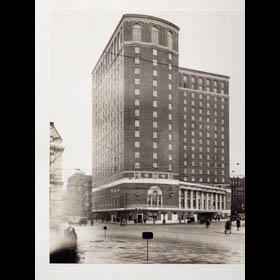
Introduction
On the evening of June 6, 1922, the Providence Biltmore Hotel opened with a formal celebration attended by 1,000 prominent Rhode Island and New York citizens. The highly anticipated hotel received enthusiastic reviews. The Providence Journal, on June 7, 1922, hailed the Providence Biltmore Hotel as a "castle that has floated in the air above these plantations for some few years," and "dropped down to earth last night…and proved by a unanimous verdict of the elected and initiated, even better as a reality than as a dream." In his welcome speech at the hotel’s opening celebration, Providence Mayor Gainer called the opening of the Providence Biltmore, "the most important event in Providence in the last 10 years." The opening of the Providence Biltmore placed the city among the most progressive and up to date in the country.
The Commission
John Bowman and Louis Wallick, the New York Entrepreneurs who owned the Providence Biltmore, commissioned the New York architecture firm Warren & Wetmore to design the hotel. Whitney Warren (1/29/1864 - 1/24/1943) and Charles Wetmore (1867 - 5/9/1941) had formed Warren & Wetmore in 1896 and had a reputation for designing modern hotels throughout the 1900’s.
The Building
The Providence Biltmore Hotel is located at 11 Dorrance Street on the triangular area bounded by Dorrance, Washington, and Eddy Streets facing Kennedy Plaza in downtown Providence. By looking at the photograph showing the hotel’s exterior, it is evident that the hotel is L-shaped. This allows all guests to have unobstructed views of Providence out of any window. Also shown in the photograph of the 19-story hotel is the large ballroom on the top floor that boasts double-story, round-arched windows. The architects designed the hotel using brick, stone, and steel. A steel frame structure covered with sheathed brick and stonewalls created this neo-Federal and Italian Renaissance hotel. The hotel was designed with a 3-story base beneath the 16 stories of hotel rooms. When it opened, the Biltmore housed a drugstore, printing shop, carpentry and upholstery shop, and photo lab. Customers could also choose from six different restaurants all located within the hotel. In the 1920’s, the Biltmore even had a rooftop garden where chicken coops could be found.
Recent History
In the hotel lobby one can find a plaque which commemorates Hurricane Carol which occurred 1954. The hurricane flooded the lobby and elevator shafts of the hotel. Couches floated throughout various rooms on the ground floor and nearly drifted out of the hotel through the revolving entrance doors. The plaque was placed high on the columns in the lobby marking the floodwater’s height. The effects of Hurricane Carol combined with the recession drove the hotel into debt. The Biltmore closed on January 14, 1975 after the Providence Gas Company turned off their gas service. The hotel owed nearly $200,000 in unpaid bills and taxes.
Soon after, the hotel was bought by the Business Development Company of Rhode Island. In 1979, the hotel reopened with a refurbished interior and exterior which cost nearly $13 million. Much of the Adamesque décor throughout the hotel’s interior remained the same, but two exterior changes were made. The glass-enclosed exterior elevator was installed in addition to the illuminated "BILTMORE" sign on the roof. Both exterior changes can be seen in the photograph. The hotel’s refurbishment marked the revitalization of Downtown Providence of the late 1970’s.Recent renovations since 1979 which cost $7.5 million have again followed the changing of Downtown Providence. Elegant boardrooms and luxury suites have been added to follow the upscale and metropolitan changes the city of Providence has seen throughout the late 20th century.
Sources
"Biltmore Hotel to Have Formal Opening To-Night." The Providence Journal 6 June 2002, p.1.
Cady, John Hutchins. From the Civic and Architectural Development of Providence. Providence, The Book Shop, 1957. pp. 57, 129, 201, 251-252.
Commentary. The Providence Journal 21 January 1973, G2.
Commentary. The Providence Journal 10 March 1973, p.10.
Full Page Advertisement. The Providence Journal 6 June 1922, p. 24.
"History." http://www.providencebiltmore.com/history.html
Jordy, William and Monkhouse, Christopher. Buildings on Paper, Rhode Island Architectural Drawings 1825-1945. Providence: Brown University, The Rhode Island Historical Society, and Rhode Island School of Design, 1982. p. 200.
Kellner, George. Rhode Island, The Independent State. Rhode Island: The Windsor Publications, 1982. pp. 92, 115, 150.
The Providence Journal 7 June 2002, p. 1.
The Rhode Island Conference of Business Associations, ed. The Book of Rhode Island. Providence: The Rhode Island Conference of Business Associations, 1930. p. 128.
"Warren, Whitney." http://www.bartleby.com/65/wa/warren_w.html
"Warren, Whitney." http://www.philipsemanorfriends.org/ww.htm
"Wetmore, Charles D." The New York Times 10 May 1941, Obituary.
"Wetmore, Charles D." http://www.philipsemanorfriends.org/ww.htm
Who Was Who in America, 1943-1950. "Warren, Whitney Obituary." New York Herald-Trubune 25 January 1943: Obituaries.
Woodward, William McKenzie. Providence, A City Wide Survey of Historic Resources. Providence: The Rhode Island Historical Preservation Commission, 1980. p. 170.












